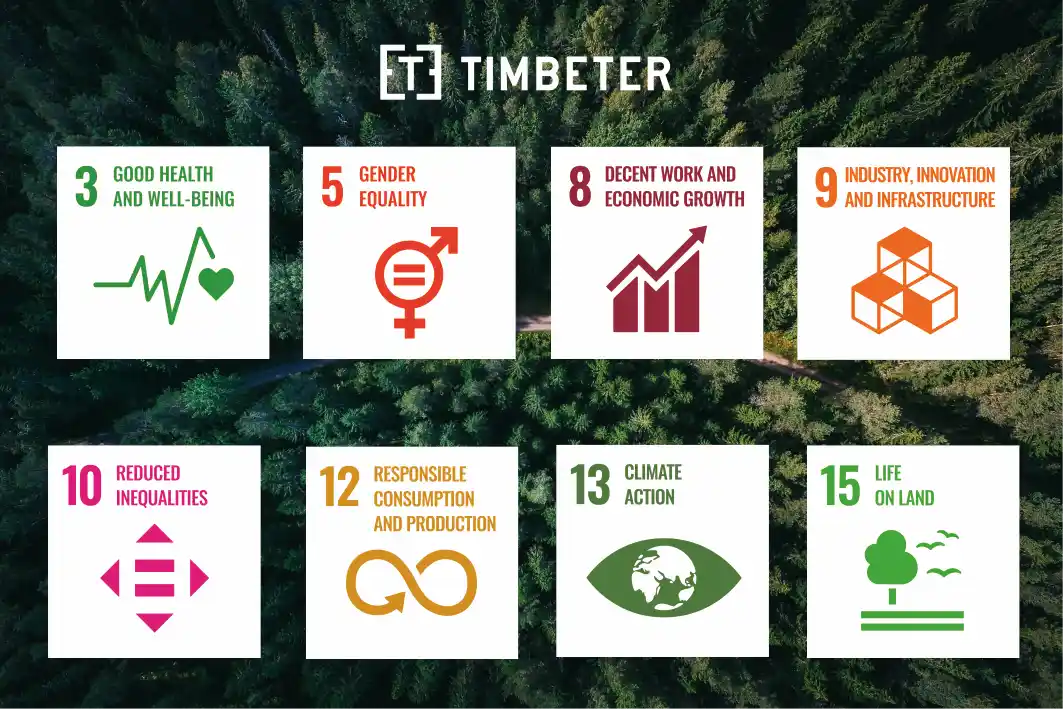Introduction
The world is facing unprecedented challenges related to climate change, biodiversity loss, and sustainable development. To address these issues, the United Nations has set 17 Sustainable Development Goals (SDGs) to be achieved by 2030. Among these goals, SDG 3 (Good Health and Well-being), SDG 5 (Gender Equality), SDG 8 (Decent Work and Economic Growth), SDG 9 (Industry, Innovation, and Infrastructure), SDG 10 (Reduced Inequality), SDG 12 (Responsible Consumption and Production), SDG 13 (Climate Action), and SDG 15 (Life on Land) are particularly relevant to the forestry sector. In this blog post, we will explore how Timbeter, an innovative technology company, is helping forestry companies contribute to the achievement of these vital SDGs.
SDG 3: Good Health and Well-being
Timbeter’s technology allows forestry companies to optimize their operations, reducing the need for manual labor and minimizing the risk of injuries. By streamlining processes and ensuring accurate measurements, Timbeter promotes a safer and healthier work environment for forestry workers.
SDG 5: Gender Equality
Gender equality is a pressing issue in the forestry industry. Timbeter’s digital solutions provide a more inclusive work environment by reducing physical demands and facilitating remote work. This inclusivity helps break down gender barriers and promotes equal opportunities for all in the sector.
SDG 8: Decent Work and Economic Growth
Timbeter’s technology enhances efficiency in forestry operations, leading to higher productivity and economic growth. It optimizes the allocation of resources and ensures sustainable practices, thereby contributing to the long-term viability of the forestry sector and the communities it serves.
SDG 9: Industry, Innovation, and Infrastructure
Timbeter’s innovative solutions leverage cutting-edge technology, such as artificial intelligence and machine learning, to revolutionize traditional forestry practices. By promoting digitalization and efficient data management, Timbeter supports the development of resilient and sustainable infrastructure in the forestry sector.
SDG 10: Reduced Inequality
Timbeter’s technology helps reduce inequality by creating more equitable opportunities for small owners within the forestry industry. It promotes fair wages, safer working conditions, and equal access to resources, helping to bridge the gap between different stakeholders in the sector.
SDG 12: Responsible Consumption and Production
Responsible consumption and production are at the core of Timbeter’s mission. By accurately measuring and tracking timber resources, Timbeter enables sustainable forestry practices, reducing overharvesting and promoting responsible resource management. Timbeter helps to ensure that each log harvested reaches its maximum potential.
SDG 13: Climate Action
Forests play a crucial role in climate mitigation, acting as carbon sinks. Timbeter’s technology ensures that forestry companies operate sustainably, helping to preserve forests and combat deforestation. Accurate measurements and detailed monitoring of the supply chain also aid in tracking carbon emissions and reducing the environmental footprint of the forestry sector.
SDG 15: Life on Land
SDG 15 focuses on protecting, restoring, and promoting sustainable use of terrestrial ecosystems. Timbeter’s solutions directly contribute by promoting sustainable forestry practices, reducing illegal logging, and ensuring the responsible management of forest resources, thus preserving biodiversity and ecosystems.
Conclusion
Timbeter’s innovative technology is making significant contributions to the achievement of multiple SDGs in the forestry sector. By promoting safety, inclusivity, efficiency, and sustainability, Timbeter is helping forestry companies align their operations with the global agenda for a better and more sustainable future. As the world works towards meeting the SDGs by 2030, the role of innovative companies like Timbeter in sustainable forestry practices becomes increasingly vital.
